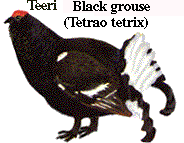
Moore information about the some birds of taigaforests here, too:
The coniferous forest belt, taiga, which extends far in the east, has an interesting avifauna. The richness in species is defined by the share of broad-leaved trees and the lightness of the forest, though. The more broad-leaved trees there is and the lighter the spruce copse, the more abundant the species. Differences between the forests in the eastern parts of Finland and the forests in the west are quite small. It is true that there are some very rare species in the east, species of the wide taiga belt in their most eastern range such as red-flanked bluetail (Tarsiger cyanurus) in Koillismaa. In the west, the southern species are often more strongly represented than in the east, e.g. chaffinch ( Fringilla coelebs), which numerous in the west and which is “replaced” in the east by brambling (Fringilla montifringilla), which primary range is the north.
Along with chaffinches, the most common species of spruce forests are willow warbler (Phylloscopus trochilus) of sunny forests, “silent” siskin (Carduelis spinus) as well as clear-voiced singer, robin (Erithacus rubecola) and goldcrest (Regulus regulus) in the southern parts of Lapland. Other common species of spruce forests are tree pipit (Anthus trivialis), spotted flycatcher (Muscicapa striata), redwing (Turdus illacus), song thrush (T. philomelos), willow tit (Parus montanus), and Siberian tit (P. cinctus).
Annual variations of many species are great. They are either dependent on weather factors as in the case of goldcrest, or indirectly dependent on the success of spruce seed crop as in the case of the abundance of siskin.

The capercaillie eats in winter only needles of pine.
The resttime it is under the snow. This bird is the largest forest bird
in the northern countriesliving in the old coniferous forests. Nowadays
the populations of capercaillie are alarming diminishing since the felling of old forests.
A male display-garbed black grouse is a glory! Black grouse in wintertime stays
on the birches,where it feels for catkinbuds. Nowadays the quantity of black grouse is increasing.
Look at female black grouse in the nest.
Compare also with fluctuation of populations!
Species of northern spruce forests that are typical but few in number are black grouse (Tetrao tetrix) , wood grouse (T. urogallus) and hazel-grouse (Bonasa bonasia) of fowls, and chiffchaff (Phylloscopus collybita), dunnock (Prunella modularis), wren (Troglodytes troglodytes) and raven (Corvus corax) of other birds. The lucky bird of the north, Siberian jay (Perisoreus infaustus), shows up on rest areas in every forest. The most common of woodpeckers is three-toed woodpecker (Picoides tridactylus), a typical bird of spruce forests that does not have red colouring. Great spotted woodpecker (Dendrocopos major) that thrives in broad-leaved forests appears also in coniferous forests searching for seeds in winter. The big rare bird of old spruce forests, great grey owl (Strix nebulosa), may appear during good small rodent years.
Northern coniferous species that are silent in summer include pine grosbeak (Pinicola enucleator), bullfinch (Pyrrhula pyrrhula) and waxwing (Bombycilla garrulus). They are best detected in a winter forest when they are searching for berries, often in big flocks.
Species in lighter, drier and at the same time barren pine forests varies strongly every year. Pine forest is a sort of extreme biotope because in good years, the species multiply visibly as the nesting pressure increases in the “normal”, more humid biotopes of the species. It is not always possible to find a predominant species in pine forests. Nevertheless, the species are almost the same as in spruce forest, only the order of abundance may be different. The most common birds also in here are chaffinches, tree pipit, and willow warbler. Redstart (Phoenicurus phoenicurus) is more common in pine forests than in spruce forests. Furthermore, the same applies often to spotted flycatcher, pied flycatcher as well as willow tits and Siberian tits. Mistle thrush (Turdus viscivorus) is a type species of light pine heaths but it is almost invisible from the beginning of its nesting period.
In good pine seed years, parrot crossbill (Loxia pytyopsittacus) and crossbill (L. curvirostra) are the most numerous species in pine forests but early nesting (March) causes them to be hardly visible in summer.
The section "Taiga forest birds" ends here!
If you like some other birds, click here!
If you like some other animals, click here!
Other sections: Control menu on the upper part of this screen!